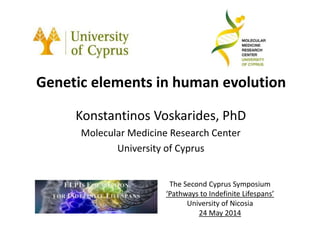
Voskarides 2nd aging symposium-unic 240514
- 1. Genetic elements in human evolution Konstantinos Voskarides, PhD Molecular Medicine Research Center University of Cyprus The Second Cyprus Symposium ‘Pathways to Indefinite Lifespans’ University of Nicosia 24 May 2014
- 2. What is the relevance between longevity/aging and evolution? • There is strong evidence that longevity and aging rate are highly heritable traits • There is also evidence that longevity and aging rate are selectionable traits • Different species and even different human populations have different age limits and age medians. Evolutionary history counts!
- 3. “Big data” help to study human evolution • A huge DNA information is now publicly available, regarding the human and other species’ genomes • HapMap project, 1000 genomes project, Neanderthal project, other organisms’ genomes • Next Generation Sequencing enhanced exponentially the production of massive genetic information • Productivity rate is continuously increasing: A new company being started by J. Craig Venter (called “Human Longevity”) aims at releasing 100,000 genomes per year! From infants to centenarians
- 4. • Despite the vast available genetic information (healthy individuals, patients, fossils), genetic associations found are proportionally few • For most common multifactorial diseases, the discovered genetic variants explain only 5-10% of heritability • Known genetic loci under selection, with strong evidence for this, are few
- 5. Few adaptive loci have been discovered…
- 6. NATURE|Vol 456|6 November 2008
- 7. So, can we trace more efficiently human evolution? Many geneticist believe (I do!) that the key is to understand better the function of genetic regulatory elements.
- 8. Hypothesis: “Human genome (probably all species’ genomes) is highly governed by specific genetic elements that can influence dynamically the function of genes. These elements may have contradictory roles and co-evolve through evolutionary time”
- 9. Known “Genetic elements” with qualitative or quantitative action in genomes • Copy Number Variations (CNVs): Discovered on 2006. Gains and losses of large chunks of DNA sequence. Gains can increase gene expression through multiple gene copies. • microRNAs and other non-coding RNAs: Affect negatively mRNA translation. They fine tune gene expression. • Transposons: DNA fragments moving through the genome. They can potentially affect the expression of nearby genes, or they can incorporate regulatory elements (e.g. microRNAs). • DNA Repair Genes (DRGs): Eliminate the randomly inserted mutations. Master regulators of mutagenesis rate in genomes. • Genes acting at epigenetic level: Can affect positively or negatively gene expression.
- 10. Evolutionary studies exist for some of these elements
- 13. Examples of studied binary interactions
- 17. CNVs vs epigenetic modifications
- 18. Micro-RNAs vs CNVs. Our work…
- 21. DNA repair genes: Masters regulators of mutagenesis rate. Is mutagenesis rate changing through evolutionary time?
- 22. DNA repair genes (DRGs) 176 known human DNA repair genes Main types of repair: • Direct reversal • Single-strand damage • Double-strand breaks - non-homologous end joining (NHEJ) - microhomology-mediated end joining (MMEJ) - homologous recombination
- 23. Escaping repair. Why? SOS mechanism in bacteria. An error-prone repair system. It may explain resistance evolution in antibiotics.
- 25. Limited information regarding eukaryotic species
- 26. DRGs & cancer • Mutations in DRGs can cause cancer • BRCA1, WRN, FANCB, FANCF, MGMT, MLH1, MSH2, MSH4, ERCC1, XPF, NEIL1, ATM • Epigenetic changes in the above genes can also cause cancer • Breast cancer, colorectal cancer and others • Deficiencies in expression of ERCC1, XPF and/or PMS2 occur simultaneously in a big % of colon cancers (Facista et al, 2012)
- 27. Gillies et al, 2012 A unifying model of carcinogenesis Carcinogenesis is a highly selective procedure
- 28. Not all the species develop cancers. Why? - When in protected captive conditions, species such as wild mice (Mus musculus) can have elevated incidences of cancer (e.g., 46%) - As opposed to the wild mice, naked mole-rats (Heterocephalus glaber) have no known cancers, even in captivity Examples:
- 31. Hypothesis: “Under extreme environmental conditions, individuals (and their offspring) with accumulated genetic variation in their DRGs may have a higher probability to survive. Increased mutagenesis -> advantageous mutation/s can appear” “As a consequence, when environmental conditions are back to normal and individuals live longer, a “side-effect” of this evolutionary phenomenon maybe the increased carcinogenesis due to the increased genetic variability in the DRGs.”
- 32. Initial population. Stochastically, some individuals exist with excess of DRGs’ mutations (let’s name them IDM). Environment changed, became stressful and extreme. Many individuals die. More individuals die. Progenies of IDM have a higher probability to carry a beneficial mutation. Gradually, IDM increase in population level. Environment comes back to “normal”. Individuals live longer but the IDM ones are in high risk to develop cancer. Circles: Population individuals Shaded circles: Individuals with increased genetic variation in DNA repair genes (IDM) Line-strike circles: Individuals that developed cancer
- 33. Is this compatible with other evolutionary theories? Goldschmidt theory for punctuated equilibrium
- 35. An interesting observation • Areas that used to be covered by glaciers (last ice-age) have the higher incidence of cancer today, especially breast and colorectal cancer. • Breast and colorectal cancer are the most frequent types of cancer today and closely related with DRGs. • Infectious types of cancer, for example uterus and cervical cancer (mainly caused by HPV viruses), are not comparable with the last ice-age map.
- 36. Cancer - Male Cancer - Female Colorectal Cancer - Male Colorectal Cancer - Female Breast Cancer GLOBOCAN2008(http://globocan.iarc.fr)
- 37. In press
- 38. Conclusions • We have to increase our knowledge on Genetic Regulatory Elements. They may explain a big part of heritability. • Genomic elements co-evolve through time. Only by designing specific studies we can trace co- evolution. • Under this view, we can proceed to detect specific adaptations (skin color, nutrition, behavior, longevity etc).
- 39. Thank you!
